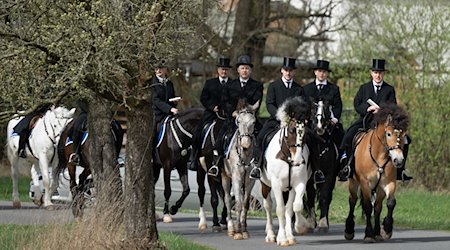Full halls and parades: Saxony's carnivalists are not letting rising prices spoil their mood. Nevertheless, some clubs are struggling with rising costs, according to a survey by Deutsche Presse-Agentur. In addition, it is becoming increasingly difficult to attract sponsors, especially smaller companies, said Therèse Hennig, Vice President of the Leipzig Carnival Promotion Committee, an umbrella organization under which eight carnival clubs in the city have joined forces.
About 189 carnival clubs from Saxony with around 25,000 carnivalists are organized in the Saxon Carnival Association. The number has remained roughly constant for years, said association spokesperson Michael Rohde. Carnival in Saxony has a particularly difficult time in cities with a wide range of cultural activities. In addition, smaller municipalities are often more cooperative when it comes to working together. Members have to be recruited. However, the clubs tend to have problems recruiting young people. The girls, on the other hand, enjoyed joining the funkengarden and trained there several times a week.
Anniversary parade in Leipzig
The Leipzig carnivalists are not celebrating without a care in the world. Accompanied by many foolish visitors at the roadside, as Therèse Hennig hopes, the carnivalists will parade through the streets of the trade fair city for the 25th time on the Sunday before Rose Monday. "Registrations for participation in the parade have been falling for years," complained Hennig. 26 carnival floats will be taking part.
"Unfortunately, some carnival clubs simply no longer exist or no longer have the financial means to do so." The costs for the vehicles and the participation fee were a problem for them. Rising costs for the stage on the market square, barriers, security, street cleaning and the fees charged by the city made the parade more and more of a "financial feat".
The coronavirus pandemic and rising costs have made everything worse. "Nevertheless, we are looking forward to our anniversary parade," said Hennig. Leipzig carnival clubs had brought carnival to the streets of Leipzig together from the year 2000. "We continue to fight for a colorful carnival in Leipzig," said Hennig. This is particularly important for children and young people.
After the parade, the Leipzig jesters want to celebrate together with the carnival mascot, the lioness Leila, on the market square with singing and a show program with cheerleaders and dance groups. The highlight will be the awarding of the "Golden Rose" for special carnival achievements and the "Golden Wagon Wheel" challenge cup for the most original float.
More parade participants in Radeburg
Things are going better at Saxony's biggest carnival party, the "Rabu", as the carnival in Radeburg not far from Dresden is known. According to Kai Drabe, Chairman of the Board and President of the Radeburg Carnival Club, 70 "pictures" will take part in the parade. "Compared to 2019 and 2023, we actually have more participants in this year's parade." The parade on Sunday will last around three hours.
The town with around 7300 inhabitants attracts up to 50,000 spectators from the entire region every year for the "Rabu". During the parties, the entire market square is covered by a large marquee. One of the highlights is a firework display at the end of the season on Shrove Tuesday.
Jesters in Wittichenau celebrate 318th season
After the coronavirus pandemic, the Upper Lusatian jesters in Wittichenau are back in party mood. "After a forced break of two years, we had an excellent 317th carnival season last year and the 318th season is also going very well," said Mathias Glaab, President of the Wittichenau Carnival Association. "We have sold-out hall events and we are even seeing a slight increase in the number of active floats and foot groups in the parades." We are talking about around 100 foot groups and 20 to 30 floats accompanied by heralds. The number of members in the association has remained roughly the same.
The highlights of the season are the big parades at Weiberfasching and on Rose Monday. However, the general rise in prices has not spared the carnival, said Glaab. "We have therefore moderately adjusted our admission prices."
Carnival has been celebrated in Wittichenau since 1706. It is probably Saxony's oldest and most traditional carnival. During the carnival days, almost every garage, barn or other building is transformed into an open-air bar where jesters are entertained. The costume groups show off their new creations at the big masquerade ball. The Women's Carnival parade on Saturday belongs to the women. Up to several thousand guests then flock to the small town in Upper Lusatia for the Rose Monday parade.
Dresden has already had visitors
In Dresden, the carnival has retreated into the halls. One of the highlights this year was the visit of the 1st Great Salzburg Carnival Guild. The guests from Dresden's twin city also attended the first carnival party of the year at Dresden's traditional Ballhaus Watzke. Next year, the Dresdeners will make a return visit to Salzburg. More than 100 years ago, the carnival parades in the state capital still had Rhineland dimensions with huge crowds of onlookers. Now, carnival is mainly celebrated in the halls.
Copyright 2024, dpa (www.dpa.de). All rights reserved










